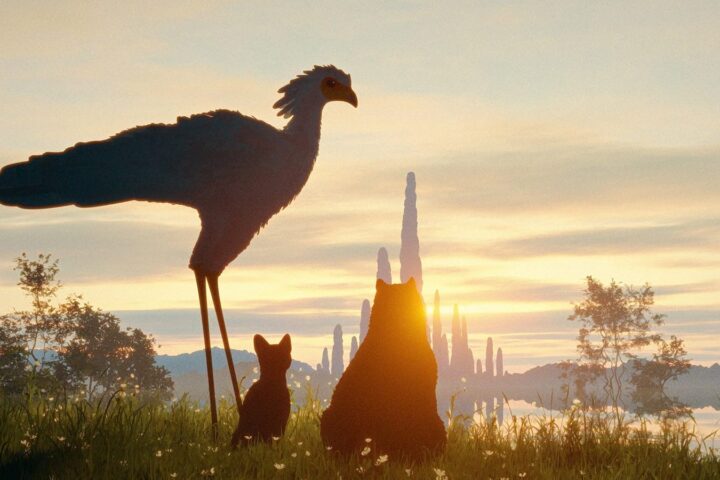None of the characters in Latvian animator Gints Zilbalodis’s poignant, vividly realized Flow utter a single word. They’re all animals, which normally wouldn’t keep them from talking in an animated feature, but so much of what makes Flow so rewarding and unexpected is how Zilbalodis resists the temptation to anthropomorphize his CGI critters.
The film’s concise visual language expertly immerses us in its post-apocalyptic narrative, which follows the journey of a black cat in a human-less world devastated by a cataclysmic flood. Fearful and suspicious, the cat eventually boards a sailboat as water swallows the landscape, falling in with other animals whose personalities are just as easy to decipher: a chilled-out capybara, a hoarding lemur, an excitable Labrador retriever, and a high-strung secretarybird. We’re never at a loss to know how the cat feels at any given moment, as Zilbalodis finds multitudes in the position of its ears, the wideness of its pupils, and the skittering of its legs.
In some of the film’s more intense sequences, the camera glides alongside the cat in breathless, unbroken shots as the animal flees a pack of dogs or nearly drowns beneath waves. Though Flow, which is movingly attuned to its characters’ primal instincts, is largely suitable for family viewing, its sense of peril is all the more acute because of how realistic the creatures seem, tapping into the distress we’re gripped by when we watch struggling animals.
The film’s presentation will invite video game comparisons, whether in its cutscene-like action scenes or its semi-realistic 3D environments bathed in heavy sunlight. BlueTwelve Studio’s indie hit Stray, about a cat with a robot companion traversing a post-apocalyptic world, will be the most obvious point of comparison. Yet, Flow doesn’t feel like most games because its images speak for themselves, with the lack of exposition (like, say, graffiti or diaries revealing what happened to humanity) allowing the film to maintain a brisk, compelling pace.
Except perhaps in the broadest strokes about cooperation and coexistence, Flow isn’t nakedly allegorical. Here, we watch and wonder at things like the strange, monolithic animal statues or an ethereal beam of light before the cat presses onward. Such images gain beauty and mystery because the film lacks pat scenes of characters idly speculating about the pre-apocalyptic world or despairing over what will become of them. In the face of what may very well be inevitable doom, the animals can only move forward and adapt—if they can. Flow is never held back by its lack of words because, through sheer skill and craft, it transcends the very need for them.
Since 2001, we've brought you uncompromising, candid takes on the world of film, music, television, video games, theater, and more. Independently owned and operated publications like Slant have been hit hard in recent years, but we’re committed to keeping our content free and accessible—meaning no paywalls or fees.
If you like what we do, please consider subscribing to our Patreon or making a donation.



